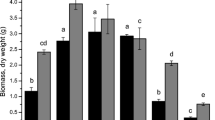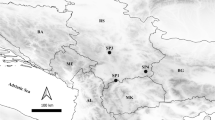Abstract
Rare earth elements (REEs) have been widely used in recent decades, and their exploitation has led to industrial REE emission and to contaminated soils especially in former mining areas. This raised people concerns on the accumulation and toxicity of REEs in soils and plants, and consequences on plant health. Although many studies dealt with REE in soils and plants, there is still a need to precise their toxicity, bioavailability and transfer to plants in contaminated sites in order to restore such ecosystems. We studied the bioavailability and transfer of a REE to Medicago sativa grown on two contaminated soils differing in their chemical characteristics. A pot experiment was set up in a growth chamber where two natural soils were spiked or not with samarium (Sm) as a model REE. Two chemical extractants were tested to estimate the bioavailability of Sm in the soil, its decrease with time and its transfer to the plants. Results showed that DTPA extractable Sm was well correlated with Sm uptake in alfalfa shoots. The experiment pointed out a significant ageing effect since DTPA extractable Sm significantly decreased within 2 weeks in the soils and was significantly lower in the less acidic soil than in the other. The uptake of Sm from soil to alfalfa shoots depended on the soil pH and on the spiking concentration. The soil to plant transfer factor was low (< 0.08), but a 30% reduction of alfalfa biomass was observed when the soils were spiked with 100 to 200 mg kg−1 of Sm.





Similar content being viewed by others
References
Asher CJ, Smith FW (1995) Rare earth elements and plant growth: II. Responses of corn and mungbean to low concentrations of lanthanum in dilute, continuously flowing nutrient solutions. J Plant Nutr 18:1977–1989
Ashrafi E, Razmjoo J, Zahedi M (2018) Effect of salt stress on growth and ion accumulation of alfalfa (Medicago sativa L.) cultivars. J Plant Nutr 41:818–831
Babula P, Adam V, Opatrilova R, Zehnalek J, Havel L, Kizek R (2008) Uncommon heavy metals, metalloids and their plant toxicity: a review. Environ Chem Lett 6:189–213
Bibak A, Stümp S, Knudsen L, Gundersen V (1999) Concentrations of 63 elements in cabbage and sprouts in Denmark. Commun Soil Sci Plant Anal 30:2409–2418
Brioschi L, Steinmann M, Lucot E, Pierret MC, Stille P, Prunier J, Badot PM (2013) Transfer of rare earth elements (REE) from natural soil to plant systems: implications for the environmental availability of anthropogenic REE. Plant Soil 366:143–163
Cao X, Chen Y, Gu Z, Wang X (2000a) Determination of trace rare earth elements in plant and soil samples by inductively coupled plasma-mass spectrometry. Int J Environ Anal Chem 76:295–309
Cao X, Wang X, Zhao G (2000b) Assessment of the bioavailability of rare earth elements in soils by chemical fractionation and multiple regression analysis. Chemosphere 40:23–28
Carpenter D, Boutin C, Allison JE, Parsons JL, Ellis DM (2015) Uptake and effects of six rare earth elements (REEs) on selected native and crop species growing in contaminated soils. PLoS One 10:e0129936
Carter MR, Gregorich EG (2007) Soil sampling and methods of analysis, 2nd edn. CRC Press, Boca Raton
Censi P, Cibella F, Falcone EE, Cuttitta G, Saiano F, Inguaggiato C, Latteo V (2017) Rare earths and trace elements contents in leaves: a new indicator of the composition of atmospheric dust. Chemosphere 169:342–350
Chao Y, Liu W, Chen Y, Chen W, Zhao L, Ding Q, Wang S, Tang YT, Zhang T, Qiu RL (2016) Structure, variation, and co-occurrence of soil microbial communities in abandoned sites of a rare earth elements mine. Environ Sci Technol 50:11481–11490
Chen Z, Chen Z, Bai L (2016) Rare earth element migration in gullies with different Dicranopteris dichotoma covers in the Huangnikeng gully group, Changting County, Southeast China. Chemosphere 164:443–450
Cheng J, Ding C, Li X et al (2015) Rare earth element transfer from soil to navel orange pulp (Citrus sinensis Osbeck cv. Newhall) and the effects on internal fruit quality. PLoS One 10:1–15
Chyi LL (2003) Trace elements in soils and plants, 4th Editio. CRC Press, Boca Raton
d’Aquino L, de Pinto MC, Nardi L, Morgana M, Tommasi F (2009) Effect of some light rare earth elements on seed germination, seedling growth and antioxidant metabolism in Triticum durum. Chemosphere 75:900–905
Diatloff E, Smith FW, Asher CJ (1995a) Rare earth elements and plant growth: III. Responses of corn and mungbean to low concentrations of cerium in dilute, continuously flowing nutrient solutions. J Plant Nutr 18:1991–2003
Diatloff E, Smith FW, Asher CJ (1995b) Rare earth elements and plant growth: I. Effects of lanthanum and cerium on root elongation of corn and mungbean. J Plant Nutr 18:1963–1976
Diatloff E, Asher CJ, Smith FW (1996) Concentrations of rare earth elements in some Australian soils. Aust J Soil Res 34:735–747
Fiket Ž, Medunić G, Furdek Turk M, Ivanić M, Kniewald G (2017) Influence of soil characteristics on rare earth fingerprints in mosses and mushrooms: example of a pristine temperate rainforest (Slavonia, Croatia). Chemosphere 179:92–100
Gonzalez V, Vignati DAL, Leyval C, Giamberini L (2014) Environmental fate and ecotoxicity of lanthanides: are they a uniform group beyond chemistry? Environ Int 71:148–157
He H, Fan C, Peng Q, Wu M, Zheng J, Wu GL (2019) Bioaccumulation and translocation of rare earth elements in two forage legumes grown in soils treated with coal fly ash. Chem Geol 528:119284
Hong F, Wang L, Liu C (2003) Study of lanthanum on seed germination and growth of rice. Biol Trace Elem Res 94:273–286
Khan AM, Behkami S, Yusoff I, Md Zain SB, Bakar NKA, Bakar AFA, Alias Y (2017) Geochemical characteristics of rare earth elements in different types of soil: a chemometric approach. Chemosphere 184:673–678
Kim RY, Yoon JK, Kim TS, Yang JE, Owens G, Kim KR (2015) Bioavailability of heavy metals in soils: definitions and practical implementation—a critical review. Environ Geochem Health 37:1041–1061
Li F, Shan X, Zhang S (2001) Evaluation of single extractants for assessing plant availability of rare earth elements in soils. Commun Soil Sci Plant Anal 32:2577–2587
Li R, Shi F, Fukuda K, Yang Y (2010) Effects of salt and alkali stresses on germination, growth, photosynthesis and ion accumulation in alfalfa ( Medicago sativa L.). Soil Sci Plant Nutr 56:725–733
Li J, Verweij RA, van Gestel CAM (2018) Lanthanum toxicity to five different species of soil invertebrates in relation to availability in soil. Chemosphere 193:412–420
Liang T, Zhang S, Wang L, Kung HT, Wang Y, Hu A, Ding S (2005) Environmental biogeochemical behaviors of rare earth elements in soil-plant systems. Environ Geochem Health 27:301–311
Liang T, Li K, Wang L (2014) State of rare earth elements in different environmental components in mining areas of China. Environ Monit Assess 186:1499–1513
Loell M, Albrecht C, Felix-Henningsen P (2011a) Rare earth elements and relation between their potential bioavailability and soil properties, Nidda catchment (Central Germany). Plant Soil 349:303–317
Loell M, Reiher W, Felix-Henningsen P (2011b) Contents and bioavailability of rare earth elements in agricultural soils in Hesse (Germany). J Plant Nutr Soil Sci 174:644–654
MacMillan GA, Clayden MG, Chételat J et al (2019) Environmental drivers of rare earth element bioaccumulation in freshwater zooplankton. Environ Sci Technol 53:1650–1660
Menzies NW, Donn MJ, Kopittke PM (2007) Evaluation of extractants for estimation of the phytoavailable trace metals in soils. Environ Pollut 145:121–130
Pagano G (2016) Rare earth elements in human and environmental health, 1st edn. Jenny Stanford, Singapore
Papastefanou C, Manolopoulou M, Stoulos S, Ioannidou A, Gerasopoulos E (1999) Soil-to-plant transfer of 137Cs, 40K and 7Be. J Environ Radioact 45:59–65
Rao CRM, Sahuquillo A, Lopez-Sanchez JF (2010) Comparison of single and sequential extraction procedures for the study of rare earth elements remobilisation in different types of soils. Ananlytica Chim Acta 662:128–136
Redon PO, Béguiristain T, Leyval C (2009) Differential effects of AM fungal isolates on Medicago truncatula growth and metal uptake in a multimetallic (Cd, Zn, Pb) contaminated agricultural soil. Mycorrhiza 19:187–195
Sahuquillo A, Rigol A, Rauret G (2003) Overview of the use of leaching/extraction tests for risk assessment of trace metals in contaminated soils and sediments. TrAC Trends Anal Chem 22:152–159
Šmuc NR, Dolenec T, Serafimovski T et al (2012) Geochemical characteristics of rare earth elements (REEs) in the paddy soil and rice (Oryza sativa L.) system of Kočani Field, Republic of Macedonia. Geoderma 183–184:1–11
Thomas PJ, Carpenter D, Boutin C, Allison JE (2014) Rare earth elements (REEs): effects on germination and growth of selected crop and native plant species. Chemosphere 96:57–66
Turra C, De Nadai Fernandes EA, Bacchi MA et al (2013) Rare earth elements in citrus production systems. J Plant Nutr 36:762–771
Tyler G (2004) Rare earth elements in soil and plant systems - a review. Plant Soil 267:191–206
Tyler G, Olsson T (2001) Plant uptake of major and minor mineral elements as influenced by soil acidity and liming. Plant Soil 230:307–321
van der Ent A, Echevarria G, Baker AJM, Morel JL (2018) Agromining: farming for metals. Springer International Publishing, Cham
Xiangsheng L, Jiachen W, Jun Y, Yubin F, Yanping W, He Z (2006) Application of rare earth phosphate fertilizer in Western area of China. J Rare Earths 24:423–426
Xu X, Zhu W, Wang Z, Witkamp GJ (2002) Distributions of rare earths and heavy metals in field-grown maize after application of rare earth-containing fertilizer. Sci Total Environ 293:97–105
Yuan M, Guo M-N, Liu W-S, Liu C, van der Ent A, Morel JL, Huot H, Zhao WY, Wei XG, Qiu RL, Tang YT (2017) The accumulation and fractionation of rare earth elements in hydroponically grown Phytolacca americana L. Plant Soil 421:67–82
Yufeng Z, Zhenghua W, Xiaorong W et al (2003) Mobility of the rare earth elements with acid rainwater leaching in the soil column. Bull Environ Contam Toxicol 67:399–407
Zhuang M, Zhao J, Li S, Liu D, Wang K, Xiao P, Yu L, Jiang Y, Song J, Zhou J, Wang L, Chu Z (2017) Concentrations and health risk assessment of rare earth elements in vegetables from mining area in Shandong, China. Chemosphere 168:578–582
Acknowledgments
The authors would like to give thanks to the technical staff of LIEC especially David BILLET, Christine FRIRY and Hervé MARMIER and to the Experimental phytotronic platform of Lorraine (PEPLor, Université de Lorraine).
Funding
This work was supported by the French National Research Agency through the national programme Investissements d’avenir with the reference ANR-10-LABX-21-RESSOURCES21.
Author information
Authors and Affiliations
Corresponding author
Additional information
Responsible Editor: Kitae Baek
Publisher’s note
Springer Nature remains neutral with regard to jurisdictional claims in published maps and institutional affiliations.
Electronic supplementary material
ESM 1
(PDF 500 kb)
Rights and permissions
About this article
Cite this article
Hu, R., Beguiristain, T., De Junet, A. et al. Bioavailability and transfer of elevated Sm concentration to alfalfa in spiked soils. Environ Sci Pollut Res 27, 44333–44341 (2020). https://doi.org/10.1007/s11356-020-09223-z
Received:
Accepted:
Published:
Issue Date:
DOI: https://doi.org/10.1007/s11356-020-09223-z




